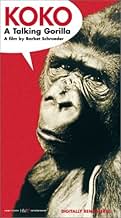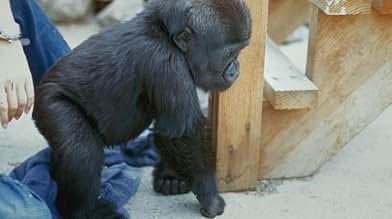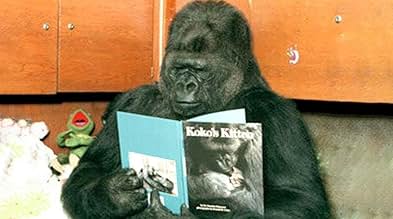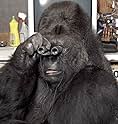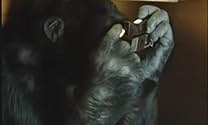Koko, le gorille qui parle
- 1978
- Tous publics
- 1h 25m
IMDb RATING
7.2/10
976
YOUR RATING
A documentary that follows Dr. Penny Patterson's current scientific study of Koko, a gorilla who communicates through American Sign Language.A documentary that follows Dr. Penny Patterson's current scientific study of Koko, a gorilla who communicates through American Sign Language.A documentary that follows Dr. Penny Patterson's current scientific study of Koko, a gorilla who communicates through American Sign Language.
- Awards
- 1 nomination total
Featured reviews
Meet Koko, all-American girl-rilla.... The reason why I refer to Koko as I do has to do with Koko's trainer, Penny Patterson's justification for why (as a scientific researcher) she is teaching this gorilla to communicate as a human being by using sign language.
Believe me, what Patterson says in her rationale is totally laughable (and embarrassing), especially since she says it with such straight-faced sincerity.
Anyway - For the most part, this 1978 documentary was an fairly interesting view, which certainly had its equal share of good points, as well as its not-so-good points.
But, from where I am sitting - I'm dead-set against this whole idea of trying to make another animal view the world from a strictly human perspective. What I saw Penny doing was destroying the gorilla in Koko and, with that, turning her into just another spoilt, pampered, American, brat.
I really felt sorry for Koko having to endure Penny in her face all the time, demanding that she "talk" (sign) and, otherwise, behave like a human instead of a gorilla.
Yes. The viewer does hear both sides of this whole argument, regarding Koko's language learning, etc. - But, if you ask me - Way too much bias was shown towards Penny's side, as though what she was doing with Koko was the "right" thing.
Anyway - See for yourself. And then, you can be your own judge on the matter.
Believe me, what Patterson says in her rationale is totally laughable (and embarrassing), especially since she says it with such straight-faced sincerity.
Anyway - For the most part, this 1978 documentary was an fairly interesting view, which certainly had its equal share of good points, as well as its not-so-good points.
But, from where I am sitting - I'm dead-set against this whole idea of trying to make another animal view the world from a strictly human perspective. What I saw Penny doing was destroying the gorilla in Koko and, with that, turning her into just another spoilt, pampered, American, brat.
I really felt sorry for Koko having to endure Penny in her face all the time, demanding that she "talk" (sign) and, otherwise, behave like a human instead of a gorilla.
Yes. The viewer does hear both sides of this whole argument, regarding Koko's language learning, etc. - But, if you ask me - Way too much bias was shown towards Penny's side, as though what she was doing with Koko was the "right" thing.
Anyway - See for yourself. And then, you can be your own judge on the matter.
You've probably heard of Koko over the years. Maybe you're seen a PBS special on the internationally famous gorilla or read an article about her. Once considered a controversial experiment in primate communication, Koko now seems practically human when compared to other gorillas in the wild and that is one of the wry points raised in this candid documentary by Barbet Schroeder, a gifted filmmaker.
The day to day instruction and training you see Koko receiving from Dr. Francis "Penny" Patterson in this intimate portrait is not the kid-friendly portrait you'd expect. You get to see Koko on off days when she doesn't want to sign with Penny, when she seems bored and restless with her daily routine, or when she rebels against Penny's authority by engaging in minor destructive acts within her living area. Her home, basically a bland, institutional space with hardly any natural light, is depressing and there are few scenes with Koko enjoying the outdoors freely. Despite Dr. Patterson's assurances that she is making incredible breakthroughs in communication between humans and apes, viewers may get the feeling that Koko is being brainwashed through repetitious instruction. Her only other exposure to gorillas is Michael, a young ape who is also being trained to communicate using American sign language. Is Dr. Patterson raising a new breed of gorillas who will only be able to sign with each other and research scientists in a private facility of Stanford University? Can Koko, who was once housed in the San Francisco Zoo, communicate with apes in the wild or even zoo apes? The real problem is that Koko may not even think of herself as a gorilla anymore. You have to wonder if she might not have been better off at the San Francisco Zoo where she at least would have enjoyed more outside activity, was able to relate to other gorillas, and was free of scientific experimentation.
The most sobering thought you are left with is the current state of gorillas in the wild. Are they better off in zoos or research facilities instead of running free in the wilds where they are fair game for poachers, hunters, and the increasing crush of human progress?
The day to day instruction and training you see Koko receiving from Dr. Francis "Penny" Patterson in this intimate portrait is not the kid-friendly portrait you'd expect. You get to see Koko on off days when she doesn't want to sign with Penny, when she seems bored and restless with her daily routine, or when she rebels against Penny's authority by engaging in minor destructive acts within her living area. Her home, basically a bland, institutional space with hardly any natural light, is depressing and there are few scenes with Koko enjoying the outdoors freely. Despite Dr. Patterson's assurances that she is making incredible breakthroughs in communication between humans and apes, viewers may get the feeling that Koko is being brainwashed through repetitious instruction. Her only other exposure to gorillas is Michael, a young ape who is also being trained to communicate using American sign language. Is Dr. Patterson raising a new breed of gorillas who will only be able to sign with each other and research scientists in a private facility of Stanford University? Can Koko, who was once housed in the San Francisco Zoo, communicate with apes in the wild or even zoo apes? The real problem is that Koko may not even think of herself as a gorilla anymore. You have to wonder if she might not have been better off at the San Francisco Zoo where she at least would have enjoyed more outside activity, was able to relate to other gorillas, and was free of scientific experimentation.
The most sobering thought you are left with is the current state of gorillas in the wild. Are they better off in zoos or research facilities instead of running free in the wilds where they are fair game for poachers, hunters, and the increasing crush of human progress?
The idea that this is Dr. Patterson's current study is a little misleading since the movie itself is 42 years old. I don't really know what to think about it. It is the study of an attempt to teach ASL to a gorilla and at the same time say the words aloud to see if the gorilla can recognize speech and sign language. One thing that struck me was after showing Koko various pieces of jewelry, Koko used sign language to describe a ring as a "finger bracelet." This was a story the doctor told, it was not shown in the film. This well worth seeing. I really cannot comment further on the quality of the film as a documentary or the worthiness of the project as a scientific study.
A discreet camera captures in detail it's two simian subjects: Koko, a laid-back mountain gorilla with sign language skills, and Koko's mentor Penny, a type-A researcher whose methods include non-stop human interaction. Unsurprisingly delves into the ethical dilemma of anthropomorphism
It's extraordinary that a thought-provoking film like this can vanish so completely from public view that it prompts only three reviews on IMDb. Schroeder, a French film-maker, heard about the controversy over a "talking" gorilla that had become pawn in a struggle between academia and the comparatively stupid zoological garden industry. He hurried to San Francisco and managed to get interesting film of Dr Jenny Patterson turning her adopted pet into a performing dog-ape. Thirty years later, she is still at it with Koko, and no one could call her a quitter. Meanwhile, Koko remains obstinately at a mental age of about three, just a little bit better than the age-two of the typical hound. Nevertheless, the film is a tantalising glimpse of the past of our own species, and the film initiates an ongoing discussion about the 'human' rights of animals, one that becomes increasingly urgent as the great apes, big cats, etc., approach complete extermination by mankind.
Did you know
- TriviaA fictional movie was to be made, with Sam Shepard writing it, but eventually got called off for money problems.
- ConnectionsEdited into Koko: The Gorilla Who Talks to People (2016)
Details
- Release date
- Country of origin
- Official site
- Languages
- Also known as
- Koko, a Talking Gorilla
- Filming locations
- Production companies
- See more company credits at IMDbPro
- Runtime1 hour 25 minutes
- Sound mix
- Aspect ratio
- 1.33 : 1
Contribute to this page
Suggest an edit or add missing content


